Non-invasive Aesthetic Treatment Market Research, 2032
The global non-invasive aesthetic treatment market size was valued at $15.5 billion in 2022, and is projected to reach $37.5 billion by 2032, growing at a CAGR of 9.2% from 2023 to 2032. The non-invasive aesthetic treatment market has experienced significant growth, driven by several key factors. One major driver is the increasing number of non-surgical aesthetic procedures performed worldwide. According to data from the International Society of Aesthetic Plastic Surgery, approximately 18,857,311 non-surgical aesthetic procedures were conducted globally. This statistic reflects the growing popularity of non-invasive treatments as they offer less risk and downtime compared to surgical alternatives. Thus, the advantages offered by the non-invasive method are driving the non-invasive aesthetic treatment market growth.
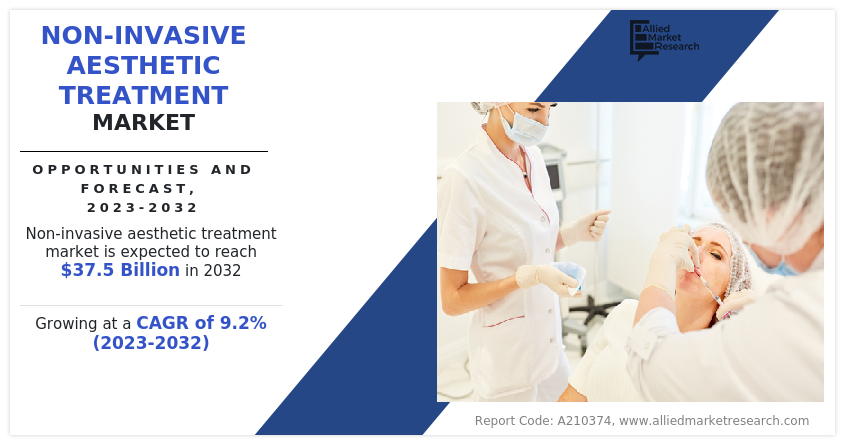
Key Takeaways
- On the basis of procedure, the injectables segment dominated the non-invasive aesthetic treatment industry in terms of revenue in 2022. However, the others segment is anticipated to grow at the fastest CAGR during the forecast period.
- On the basis of gender, the female segment dominated the market in terms of revenue in 2022 and is anticipated to grow at fastest CAGR during the forecast period.
- On the basis of age group, the 40 to 54 segment dominated the market in terms of revenue in 2022 and is anticipated to grow at the fastest CAGR during the forecast period.
- On the basis of end user, the specialty & dermatology clinics segment dominated the market in terms of revenue in 2022 and is anticipated to grow at the fastest CAGR during the forecast period.
- Region wise, North America generated the largest revenue in non-invasive aesthetic treatment industry in 2022. However, Asia-Pacific is anticipated to grow at the highest CAGR during the forecast period.
Non-invasive aesthetic treatments refer to a diverse array of cosmetic procedures and therapies designed to enhance an individual's appearance without the need for surgical incisions or invasive methods. These treatments often utilize various technologies, such as lasers, ultrasound, radiofrequency, and injectables like dermal fillers and Botox, to address a wide range of concerns, including wrinkles, fine lines, sagging skin, excess fat, and more. They are characterized by their minimally disruptive nature, typically involving little to no downtime, reduced risk, and a lower degree of discomfort compared to surgical alternatives. Non-invasive aesthetic treatments aim to improve one's physical appearance, boost self-confidence, and promote overall well-being.
Market Dynamics
The advancements in technology have made non-invasive aesthetic procedures more effective and accessible, attracting a larger number of individuals seeking to enhance their appearance without the need for invasive surgery. This trend is likely to continue propelling the expansion of the non-invasive aesthetic treatment market size.
Furthermore, key players in the market have invested in the R&D of non-invasive aesthetic treatment and have also adopted key strategies such as product launches, agreements, and acquisitions to cater to the demand for non-invasive procedures. For instance, in May 2021, Allergan Aesthetics, an AbbVie company, and Soliton announced a definitive agreement under which Allergan Aesthetics will acquire Soliton and RESONIC, its Rapid Acoustic Pulse device which recently received U.S. Food and Drug Administration (FDA) 510(k) clearance. Thus, the adoption of such strategies by key players in the market is anticipated to drive the market's growth.
However, the non-invasive aesthetics market encounters growth challenges, stemming from the high cost and inconsistent results. The costs associated with these treatments can be a barrier for many, restricting their availability. Furthermore, irregular outcomes, which vary from person to person, may result in patient discontent. The amalgamation of cost issues and inconclusive results may discourage potential clients and impact market growth. Consequently, affordability and effectiveness emerge as vital considerations for both service providers and patients.
In economic downturns, the non-invasive aesthetic treatment market can face reduced demand as consumers cut discretionary spending. However, the sector can still exhibit resilience if manufacturers offer affordable options or financing solutions. In addition, some individuals prioritize these treatments for self-esteem and professional reasons. This period can also drive manufacturers to invest in research and development, creating cost-effective products and expanding their offerings, positioning them for future growth when the economy rebounds.
Segmental Overview
The non-invasive aesthetic treatment market is segmented on the basis of procedure, gender, age group, end-user, and region. On the basis of procedure, the market is classified into injectables, skin resurfacing, and others. The injectables segment is further divided into neurotoxins, HA fillers, and non-HA fillers. The skin resurfacing segment is further divided into chemical peel, laser skin resurfacing, and microdermabrasion. The other segment is further bifurcated into laser hair removal, non-surgical fat reduction, sclerotherapy, and others. On the basis of gender, the market is categorized into female and male. On the basis of age group, the market is segregated into 13 to 39, 40 to 54, 55 to 69, and age 70 and over. On the basis of end-users, the market is fragmented into specialty & dermatology clinics, hospitals, and others. Region-wise, the market is analyzed across North America (U.S., Canada, and Mexico), Europe (Germany, France, UK, Italy, Spain, and the rest of Europe), Asia-Pacific (China, Japan, India, Australia, South Korea, and rest of Asia-Pacific), and LAMEA (Brazil, Saudi Arabia, South Africa, and rest of LAMEA).
By Procedure
The non-invasive aesthetic treatment market is segmented into injectable, skin resurfacing and others. The injectable segment accounted for the largest share in terms of revenue in 2022 and is expected to exhibit fastest CAGR growth during the forecast period. Injectables have gained immense popularity due to their ability to provide rapid, noticeable results with minimal recovery time. Additionally, their convenience, cost-effectiveness, and adaptability to meet individual preferences make them a favored option within the aesthetics sector.
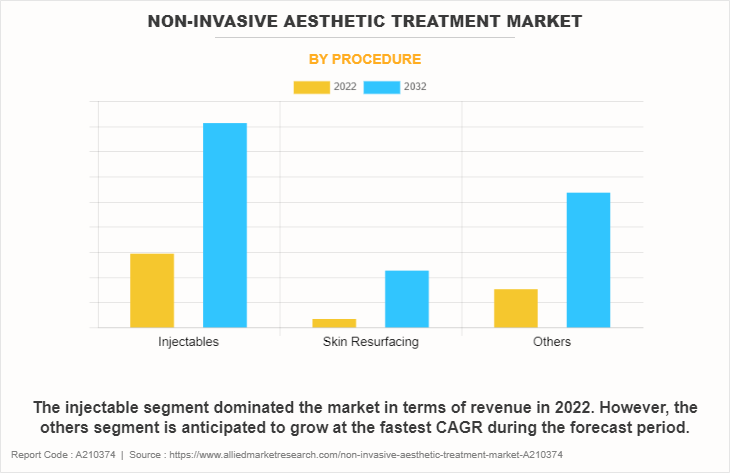
By Gender
The non-invasive aesthetic treatment market is segmented into female and male. The female segment accounted for the largest share in terms of revenue in 2022 and is expected to exhibit fastest CAGR growth during the forecast period. This is attributed to several significant factors. Females typically exhibit a wider spectrum of aesthetic concerns, encompassing anti-aging solutions, body contouring, and hair removal. The increasing awareness and societal acceptance of non-invasive aesthetic procedures have spurred a greater number of women to opt for these treatments, thus contributing to the segment's ongoing growth.
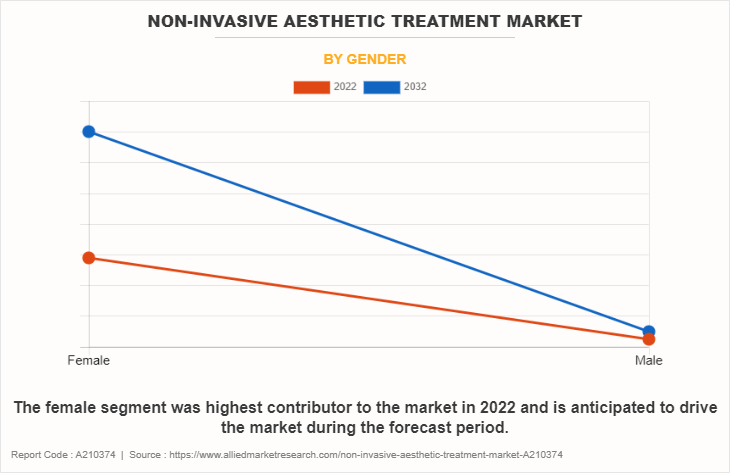
By Age Group
The non-invasive aesthetic treatment market is segmented into 13 to 39, 40 to 54‐¯and 55 to 69. The‐¯40 to 54 segment accounted for the largest non-invasive aesthetic treatment market share in terms of revenue in 2022 and is expected to exhibit fastest CAGR growth during the forecast period. The persistent demand among adults within this age bracket who seek to retain a youthful and appealing look, driven by both professional competitiveness and a societal emphasis on physical attractiveness.
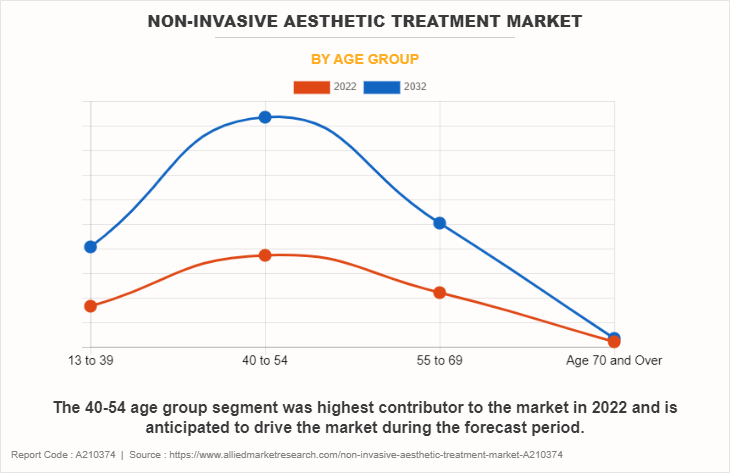
By End-user
The non-invasive aesthetic treatment market is divided into specialty & dermatology clinics, hospitals, and others.‐¯The‐¯specialty & dermatology clinics‐¯segment accounted for the largest share in terms of revenue in 2022 and is expected to exhibit fastest CAGR growth during the forecast period. The primary reasons for this growth can be attributed to a combination of factors. Specialty and dermatology clinics have emerged as key players in the non-invasive aesthetic treatment market, offering a comprehensive array of procedures, effectively becoming a one-stop destination for consumers looking to enhance their appearance through non-surgical means. These clinics are known for their expert and highly skilled medical professionals who can provide individualized guidance and advice, instilling a sense of trust and confidence in the patients seeking their services.
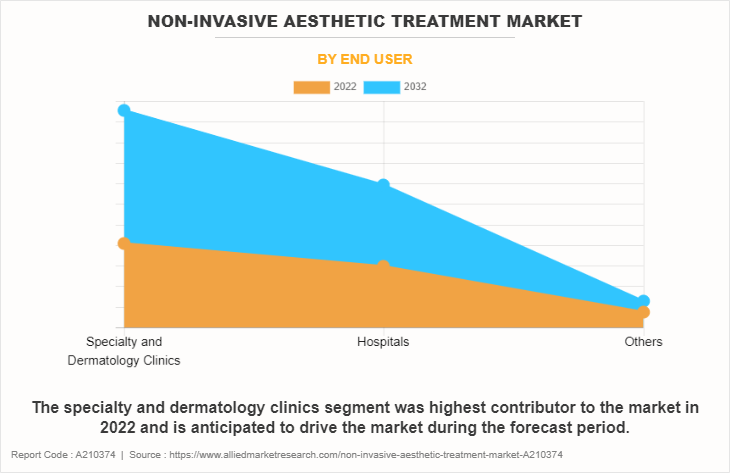
By Region
The non-invasive aesthetic treatment market is analyzed across North America, Europe, Asia-Pacific, and LAMEA. North America accounted for largest non-invasive aesthetic treatment market share in terms of revenue in 2022 and is expected to remain dominant during the forecast period owing to a rise in the availability of improved facilities, a rise in the demand for non-invasive aesthetic treatments and the growing geriatric population in this region. In addition, availability of technologically advanced medical devices and presence of well-established healthcare infrastructure are the major factor driving the growth of the non-invasive aesthetic treatment market in this region.
However, Asia-Pacific is anticipated to witness notable growth, owing to the rising disposable income, and improving standards of living have led to increased consumer spending on non-invasive aesthetic procedures. Furthermore, a growing awareness of non-invasive treatments and the desire for Western beauty standards have driven the demand for these procedures in the region.
Furthermore, a rise in research activities as well as the well-established presence of domestic companies in the region are expected to provide notable opportunities for market growth. In addition, a rise in contract manufacturing organizations within the region provides is expected to drive growth during the non-invasive aesthetic treatment market forecast.
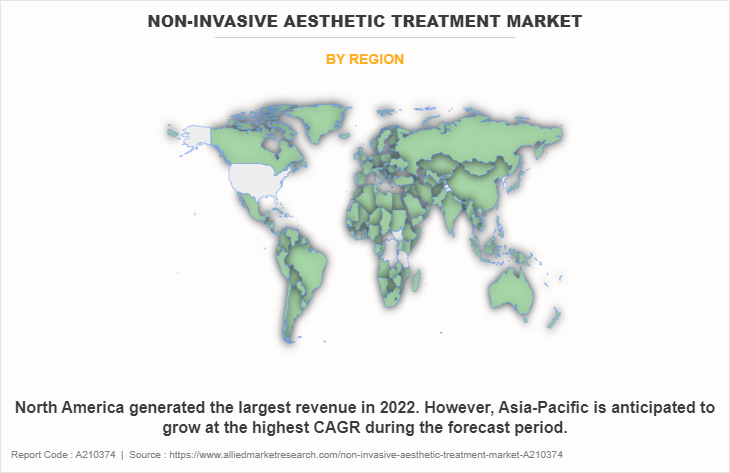
Competition Analysis
Competitive analysis and profiles of the major players in the non-invasive aesthetic treatment market such as major players that operate in the market include Cynosure Inc Sisram Medical Ltd, Abbvie Inc, Lumenis Ltd., Candela Corporation, Fotona, HTM Eletronica MerzPharma., Cutera and Bausch Health Companies Inc. The key players have adapted product launch, acquisition, collaboration, agreement, and innovation as strategies to enhance their product portfolio.
Recent Acquisition in the Non-invasive Aesthetic Treatment Market
In May 2020, AbbVie, a research-based global biopharmaceutical company, announced that it has completed its acquisition of Allergan plc following receipt of regulatory approval from all government authorities.
Recent Product launch in the Non-invasive Aesthetic Treatment Market
In January 2021, Allergan Aesthetics, an AbbVie company, announced the launch of CoolSculpting Elite, its next generation fat reduction system with applicators designed to complement the body's natural curves.
Recent Collaboration in the Non-invasive Aesthetic Treatment Market
In January 2021, Candela Corporation, the leading global medical aesthetic device company, and Merz Aesthetics the world’s largest dedicated medical aesthetics business launch commercial collaboration to provide one of the broadest medical aesthetics portfolios in the world.
Key Benefits For Stakeholders
- This report provides a quantitative analysis of the market segments, current trends, estimations, and dynamics of the non-invasive aesthetic treatment market analysis from 2022 to 2032 to identify the prevailing non-invasive aesthetic treatment market opportunity.
- The market research is offered along with information related to key drivers, restraints, and opportunities.
- Porter's five forces analysis highlights the potency of buyers and suppliers to enable stakeholders make profit-oriented business decisions and strengthen their supplier-buyer network.
- In-depth analysis of the non-invasive aesthetic treatment market segmentation assists to determine the prevailing market opportunities.
- Major countries in each region are mapped according to their revenue contribution to the global market.
- Market player positioning facilitates benchmarking and provides a clear understanding of the present position of the market players.
- The report includes the analysis of the regional as well as global non-invasive aesthetic treatment market trends, key players, market segments, application areas, and market growth strategies.
Non-invasive Aesthetic Treatment Market Report Highlights
| Aspects | Details |
| Market Size By 2032 | USD 37.5 billion |
| Growth Rate | CAGR of 9.2% |
| Forecast period | 2022 - 2032 |
| Report Pages | 320 |
| By Procedure |
|
| By Gender |
|
| By Age Group |
|
| By End User |
|
| By Region |
|
| Key Market Players | Candela Corporation., Sisram Medical Ltd., Bausch Health Companies Inc., Cynosure Inc, MerzPharma, HTM Eletronica, Fotona, AbbVie Inc., Lumenis Ltd., Cutera |
Analyst Review
The increasing demand of non-surgical technologies to enhance the aesthetic appearance globally is expected to offer profitable opportunities for the expansion of the market.
The rising expenditure on the development of healthcare infrastructure and rising personal disposable income is expected to boost the growth of non-invasive aesthetic treatment market. In addition, the growing consciousness regarding appearance is potentially driving the market growth. In addition, the increase in the number of key players offering a diverse range of non-invasive aesthetic systems such as injectables, laser skin resurfacing, hair removal, non-surgical fat removal and others are expected to boost the growth of the market.
North America has the highest market share in 2022 and is expected to maintain its lead during the forecast period, owing to the availability of improved facilities and rise in adoption of non-invasive aesthetic treatment. However, Asia-Pacific is expected to exhibit fastest growth during the forecast period, owing to high population base, rise in enhancing overall appearance and the surge in healthcare expenditure.?
Non-invasive aesthetic treatment are cosmetic procedures that enhance an individual's appearance without the need for surgical incisions.
The major factor that fuels the growth of the non-invasive aesthetic treatment are increase in consciousness regarding physical appearance, rise in adoption of non-invasive aesthetic procedures and technological advancements in non-invasive aesthetic treatment drive the growth of the global non-invasive aesthetic treatment .
The injectable segment is the most influencing segment in non-invasive aesthetic treatment.This is attributed to its popularity and effectiveness in delivering quick, visible results with minimal downtime. In addition, the convenience, relatively lower cost, and the ability to customize treatments to individual preferences have made injectables a top choice in the aesthetics industry.
Top companies such as Cynosure Inc Sisram Medical Ltd, Abbvie Inc, Lumenis Ltd., Candela Corporation, Fotona, HTM Eletronica MerzPharma., Cutera and Bausch Health Companies Inc. held a high market position in 2022. These key players held a high market postion owing to the strong geographical foothold in North America, Europe, Asia-Pacific, and LAMEA.
The base year is 2022 in non-invasive aesthetic treatment .
The market value of non-invasive aesthetic treatment in 2032 is $37,471.03 million
The forecast period for non-invasive aesthetic treatment is 2023 to 2032
The total market value of non-invasive aesthetic treatment is $15,510.94 million in 2022.
Loading Table Of Content...
Loading Research Methodology...


